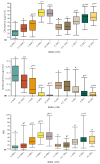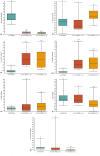β-Aminobutyric acid promotes stress tolerance, physiological adjustments, as well as broad epigenetic changes at DNA and RNA nucleobases in field elms (Ulmus minor)
- PMID: 39148013
- PMCID: PMC11325618
- DOI: 10.1186/s12870-024-05425-6
β-Aminobutyric acid promotes stress tolerance, physiological adjustments, as well as broad epigenetic changes at DNA and RNA nucleobases in field elms (Ulmus minor)
Abstract
Background: β-Aminobutyric acid (BABA) has been successfully used to prime stress resistance in numerous plant species; however, its effectiveness in forest trees has been poorly explored thus far. This study aimed to investigate the influence of BABA on morphological, physiological, and epigenetic parameters in field elms under various growth conditions. Epigenetic changes were assessed in both DNA and RNA through the use of reversed-phase ultra-performance liquid chromatography (UPLC) coupled with sensitive mass spectrometry.
Results: The presented results confirm the influence of BABA on the development, physiology, and stress tolerance in field elms. However, the most important findings are related to the broad epigenetic changes promoted by this amino acid, which involve both DNA and RNA. Our findings confirm, for the first time, that BABA influences not only well-known epigenetic markers in plants, such as 5-methylcytosine, but also several other non-canonical nucleobases, such as 5-hydroxymethyluracil, 5-formylcytosine, 5-hydroxymethylcytosine, N6-methyladenine, uracil (in DNA) and thymine (in RNA). The significant effect on the levels of N6-methyladenine, the main bacterial epigenetic marker, is particularly noteworthy. In this case, the question arises as to whether this effect is due to epigenetic changes in the microbiome, the plant genome, or both.
Conclusions: The plant phenotype is the result of complex interactions between the plant's DNA, the microbiome, and the environment. We propose that different types of epigenetic changes in the plant and microbiome may play important roles in the largely unknown memory process that enables plants to adapt faster to changing environmental conditions.
Keywords: Drought stress; Epigenetics; Forest trees; Holoepigenome; Hologenome; Non-canonical nucleobases; Plant memory; Priming; Stress tolerance; β-Aminobutyric acid.
© 2024. The Author(s).
Conflict of interest statement
The authors declare no competing interests.
Figures





Similar articles
-
Epigenomics in stress tolerance of plants under the climate change.Mol Biol Rep. 2023 Jul;50(7):6201-6216. doi: 10.1007/s11033-023-08539-6. Epub 2023 Jun 9. Mol Biol Rep. 2023. PMID: 37294468 Review.
-
The priming molecule β-aminobutyric acid is naturally present in plants and is induced by stress.New Phytol. 2017 Jan;213(2):552-559. doi: 10.1111/nph.14298. Epub 2016 Oct 26. New Phytol. 2017. PMID: 27782340
-
Soil drench treatment with ß-aminobutyric acid increases drought tolerance of potato.PLoS One. 2014 Dec 9;9(12):e114297. doi: 10.1371/journal.pone.0114297. eCollection 2014. PLoS One. 2014. PMID: 25489951 Free PMC article.
-
Comparative proteomic analysis of β-aminobutyric acid-mediated alleviation of salt stress in barley.Plant Physiol Biochem. 2016 Feb;99:150-61. doi: 10.1016/j.plaphy.2015.12.007. Epub 2015 Dec 18. Plant Physiol Biochem. 2016. PMID: 26760953
-
Plant small RNAs: the essential epigenetic regulators of gene expression for salt-stress responses and tolerance.Plant Cell Rep. 2018 Jan;37(1):61-75. doi: 10.1007/s00299-017-2210-4. Epub 2017 Sep 26. Plant Cell Rep. 2018. PMID: 28951953 Review.
References
-
- Sturrock R, Frankel S, Brown A, Hennon P, Kliejunas J, Lewis K, Worrall J, Woods A. Climate change and forest diseases. Plant Pathol. 2011;60(1):133–49.10.1111/j.1365-3059.2010.02406.x - DOI
-
- Pike CC, Koch J, Nelson CD. Breeding for resistance to tree pests: successes, challenges, and a guide to the future. J Forest. 2021;119(1):96–105.10.1093/jofore/fvaa049 - DOI
-
- Meilan R. Floral induction in woody angiosperms. New Forest. 1997;14(3):179–202.10.1023/A:1006560603966 - DOI
-
- Chang S, Mahon EL, MacKay HA, Rottmann WH, Strauss SH, Pijut PM, Powell WA, Coffey V, Lu H, Mansfield SD, et al. Genetic engineering of trees: progress and new horizons. Vitro Cell Dev Biology - Plant. 2018;54(4):341–76.10.1007/s11627-018-9914-1 - DOI
MeSH terms
Substances
LinkOut - more resources
Full Text Sources

